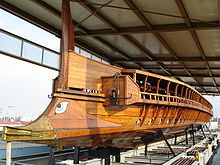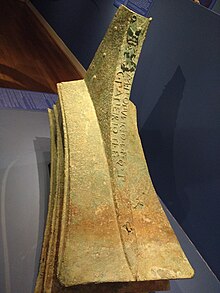Ramming

In warfare, ramming is a technique used in air, sea, and land combat. The term originated from battering ram, a siege weapon used to bring down fortifications by hitting it with the force of the ram's momentum, and ultimately from male sheep. Thus, in warfare, ramming refers to hitting a target by running oneself into the target.
Today, hand-held battering rams are one tool among many used by law enforcement and military personnel for door breaching.[1] Forcible entry by criminals has been implemented using such methods as vehicles rammed into buildings.[2]
This July 2023 needs additional citations for verification. (July 2023) |


Navies in antiquity commonly used the ram: the "beak" (
The first recorded use of a ram in modern times in fighting between major warships occurred in the American Civil War at the Battle of Hampton Roads in March 1862, when the armored Confederate warship CSS Virginia rammed the Union frigate Cumberland, sinking her almost immediately.
Another significant use of the naval ram occurred during the Third Italian War of Independence (June to August 1866) at the battle of Lissa, between Italy and Austria. The Italian ironclad Re d'Italia, damaged aft by gunfire, had no functioning rudder. Lying helpless in the water, she was struck three times by the Austrian Erzherzog Ferdinand Max, the flagship of the Austrian Commander-in-Chief Admiral Tegetthoff. The Austrian ship retreated unharmed as the Italian vessel rolled over and sank.
During the War of the Pacific of 1879-1884, the Peruvian ironclad Huascar repeatedly rammed the Chilean corvette Esmeralda, sinking the wooden steam- and wind-powered ship (May 1879).
During
In World War II (1939-1945), naval ships often rammed other vessels, though this was often due to extraordinary circumstances, as considerable damage could be caused to the attacking ship. The damage that lightly-constructed destroyers took from using the tactic led the Royal Navy to officially discourage the practice from early 1943, after HMS Hesperus spent three months in dry dock following her sinking of U-357 in December 1942, and after HMS Harvester was torpedoed and sunk after damaging her propellers during the ramming of U-444 in March 1943. USS Buckley rammed and was rammed by U-66 in May 1944; and HMS Easton rammed U-458 in 1943.
On 29 January 1943 the New Zealand naval trawlers, Kiwi and Moa rammed and wrecked the Japanese submarine I-1 in shallow water at Kamimbo Bay, Guadalcanal, during Operation Ke. The submarine of 2,135 tons was much larger and more heavily armed than the minesweeping trawlers of 607 tons each.
On 5 November 1942 the Finnish submarine Vetehinen rammed the Soviet submarine Щ 305 in the Sea of Åland and sank it. Vetehinen was on a night patrol searching for Soviet submarines. A contact was found, and after confirmation of an enemy contact, Vetehinen launched a torpedo, which missed - probably due to launching at too short a distance. Vetehinen then opened fire with its deck guns and managed to damage the Soviet submarine, which by then had started an emergency dive. The captain of Vetehinen, determined not to let the other submarine escape, ordered his submarine to ram the other vessel, which at last was a success.
During anti-submarine action, ramming was an alternative if a destroyer was too close to a surfaced submarine for her main guns to fire into the water. The famous British anti-submarine specialist Captain Frederic John Walker used this tactic from December 1941 to the end of World War II.
The British destroyer
On 2 August 1943, while returning from a "
Lt. Commander Gerard Roope, the captain of the G-class destroyer HMS Glowworm, posthumously won the Victoria Cross for the 1940 ramming of the German heavy cruiser Admiral Hipper following a close-range action in bad weather off the Norwegian coast. Recent claims suggest that Admiral Hipper was actually attempting to ram Glowworm and that the two ships simply collided.[citation needed]
During the so-called
In 1988 the Soviet
On 30 March 2020 the Venezuelan patrol-boat
Air warfare
Ramming in air combat is a last-ditch tactic that was used when all else had failed. The ramming pilot could use his entire aircraft as a ram or he could try to destroy the enemy's controls using the propeller or wing to chop into the enemy's tail or wing. Ramming took place when a pilot ran out of ammunition, yet was still eager to destroy an enemy, or when his plane had already been damaged beyond saving. Most ramming occurred when the attacker's aircraft was economically, strategically, or tactically less valuable than the enemy's, such as by pilots flying obsolescent aircraft against superior ones or by single-engine aircraft against multiple-engine bombers. Defenders rammed more often than invaders.
A ramming attack was not considered suicidal in the same manner as
Ground warfare
In World War II, at least one incident of a tank ramming an enemy tank has been reported. In 1944, an Irish Guards Sherman rammed a Tiger II during Operation Goodwood.[5]
Siege warfare
In ancient and medieval conflicts, breaching of a fortification during sieges would commonly be attempted by repeated battering of an area of a wall or gate with a battering ram, a type of siege engine.
Vehicle ramming attacks in terrorism
The
Ram-raiding is sometimes used by criminals to breach shops to steal cash or merchandise.
References
- Notes
- ^ Jon Johnson. "Police nab stalker in women's attic". Eastern Arizona Courier. Retrieved 26 November 2021.
- ^ "Bank rammed by armed robbers". Thelocal.se. 15 January 2008. Retrieved 26 November 2021.
- OCLC 1202468466.)
{{cite book}}: CS1 maint: date and year (link - ^ "PT-109". Navsource.org.
- ^ Daglish. pp. 177̣–178.
{{cite book}}: Missing or empty|title=(help) - ^ Department of Homeland Security, Federal Bureau of Investigation (14 February 2012). "DHS-FBI Warning: Terrorist Use of Vehicle Ramming Tactics". Department of Homeland Security, Federal Bureau of Investigation. Retrieved 7 September 2014.
- Jerusalem Post. 2011-08-29. Retrieved 7 September 2014.
- Bibliography
- Hardesty, Von. Red Phoenix: The Rise of Soviet Air Power 1941–1945. Smithsonian, 1991. ISBN 0-87474-510-1
- ISBN 978-0-307-26351-3.
- Sakaida, Henry. Japanese Army Air Force Aces 1937–45. Botley, Oxford, UK: Osprey Publishing, 1997. ISBN 1-85532-529-2
- Sherrod, Robert. History of Marine Corps Aviation in World War II. Washington, D.C.: Combat Forces Press, 1952.
- Takaki, Koji and Sakaida, Henry. B-29 Hunters of the JAAF. Botley, Oxford, UK: Osprey Publishing, 2001. ISBN 1-84176-161-3
- Tillman, Barrett. Corsair. United States Naval Institute, 1979. ISBN 1-55750-994-8
